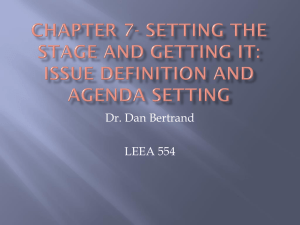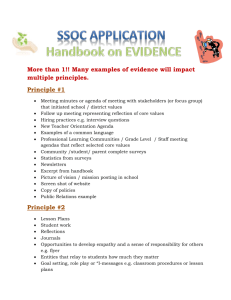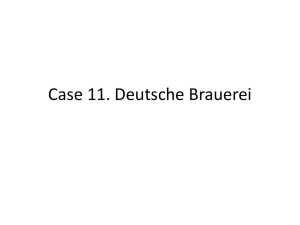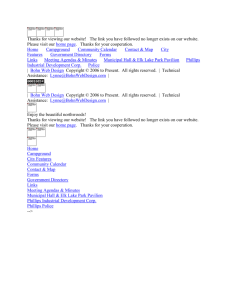Program Evaluation Sample Elementary School Strategy/Program
advertisement
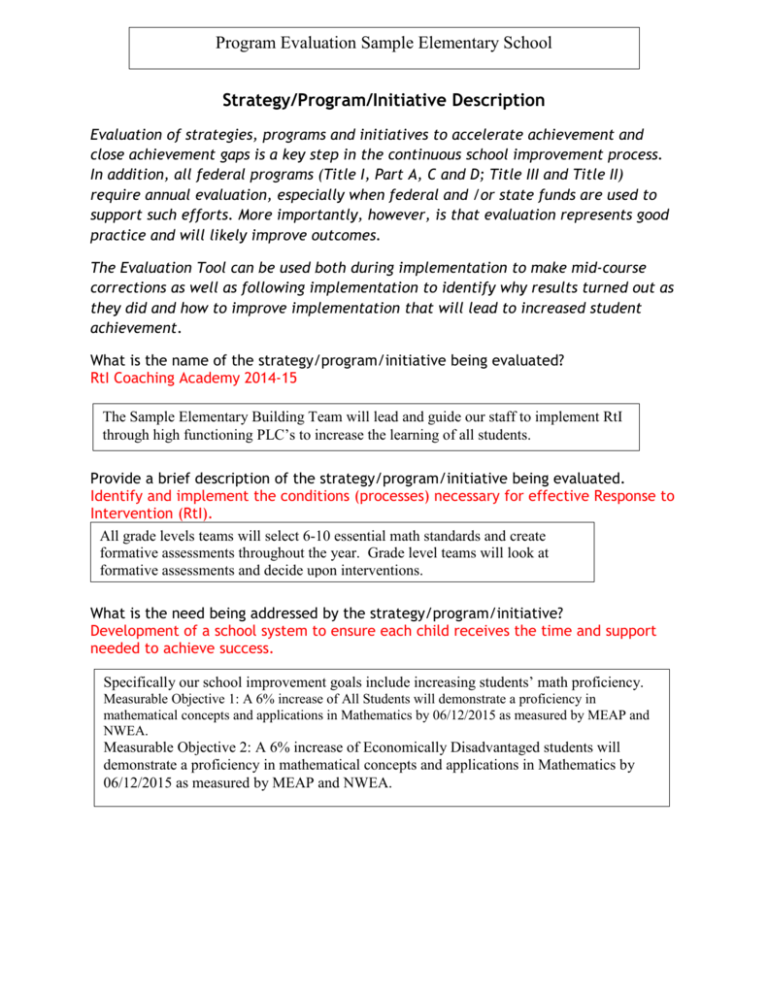
Program Evaluation Sample Elementary School Strategy/Program/Initiative Description Evaluation of strategies, programs and initiatives to accelerate achievement and close achievement gaps is a key step in the continuous school improvement process. In addition, all federal programs (Title I, Part A, C and D; Title III and Title II) require annual evaluation, especially when federal and /or state funds are used to support such efforts. More importantly, however, is that evaluation represents good practice and will likely improve outcomes. The Evaluation Tool can be used both during implementation to make mid-course corrections as well as following implementation to identify why results turned out as they did and how to improve implementation that will lead to increased student achievement. What is the name of the strategy/program/initiative being evaluated? RtI Coaching Academy 2014-15 The Sample Elementary Building Team will lead and guide our staff to implement RtI through high functioning PLC’s to increase the learning of all students. Provide a brief description of the strategy/program/initiative being evaluated. Identify and implement the conditions (processes) necessary for effective Response to Intervention (RtI). All grade levels teams will select 6-10 essential math standards and create formative assessments throughout the year. Grade level teams will look at formative assessments and decide upon interventions. What is the need being addressed by the strategy/program/initiative? Development of a school system to ensure each child receives the time and support needed to achieve success. Specifically our school improvement goals include increasing students’ math proficiency. Measurable Objective 1: A 6% increase of All Students will demonstrate a proficiency in mathematical concepts and applications in Mathematics by 06/12/2015 as measured by MEAP and NWEA. Measurable Objective 2: A 6% increase of Economically Disadvantaged students will demonstrate a proficiency in mathematical concepts and applications in Mathematics by 06/12/2015 as measured by MEAP and NWEA. Provide the reason for selecting the strategy/program/initiative, included intended results. Improve student achievement (specific to SIP goals). In our school improvement plan we had dedicated the largest amount of funds towards increasing math proficiency of all students. For this reason we will evaluate our implementation of learnings from the RtI Academy towards increasing student achievement in math. Cite the research supporting the strategy/program/initiative along with a brief summary. *Hattie, John. Visible Learning: A Synthesis of Over 800 Meta-analyses Relating to Achievement. Abingdon, Oxon: Routledge, 2009. Hattie’s synthesis of RtI metaanalyses found RtI has an effect size of 1.07 *DuFour, Richard, & Marzano, Robert. Leaders of Learning: How District, School, and Classroom Leaders Improve Student Achievement. Bloomington, IN: Solution Tree, 2011. Assisting Students Struggling with Mathematics: Response to Intervention (RtI) for Elementary and Middle SchoolsAssisting Students Struggling with Mathematics: Response to Intervention (RtI) for Elementary and Middle Schools http://ies.ed.gov/ncee/wwc/pdf/practice_guides/rti_math_pg_042109.pdf#page=32 Impact: What was the strategy/program/initiative’s impact on students? IN AN IDEAL STRATEGY/PROGRAM/INITIATIVE, the school’s achievement results on state or district wide assessments meet proficiency standards. Achievement gaps between each of the relevant subgroups and their counterparts have been narrowed as proposed in the School Improvement Plan’s measurable objectives. Interim assessment results indicate progress toward proficiency for all students to the satisfaction of all stakeholders. a) What is the evidence and what does it show regarding achievement of the measureable objective for all students when compared to baseline state and local data? b) What is the evidence and what does it show regarding achievement of the measureable objective for subgroups and their counterparts when compared to baseline state and local data? c) What is the evidence and what does it show regarding stakeholder (staff, parents, students) satisfaction with the results? d) Were the objectives for this strategy/program/initiative met? Impact Conclusion: If objectives were met, should the strategy/program/initiative be continued or institutionalized? a) What is the evidence and what does it say regarding whether this was the right strategy/program/initiative to meet your needs? b) What is the evidence and what does it say regarding whether the benefits of the strategy/program/initiative are sufficient to justify the resources it requires? c) What adjustments if any might increase its impact while maintaining its integrity? d) What is needed to maintain momentum and sustain achievement gains? e) How might these results inform the School Improvement Plan? Readiness: What was the readiness for implementing the strategy/program/initiative? IN AN IDEAL STRATEGY/PROGRAM/INITIATIVE, stakeholders are well-prepared to implement the program. They have read and can articulate the research foundation, and regularly use the terms in conversation with each other, students, and with parents. Staff, students and parents express a high level of interest in, support for and commitment to the program. Specific concerns have been identified and solutions have been planned/ implemented. Staff is able to seamlessly integrate the program within the context of other building/district initiatives. a) What is the evidence regarding stakeholder understanding of the need as well as stakeholder ability to articulate the research regarding the choice of the strategy/program/initiative? Meeting agendas/minutes Books/papers about the program Staff surveys School Improvement Plan elements Professional development materials Conference/workshop attendance Data collection plan; data analysis work Stakeholder survey results Suggestion box ideas collected School improvement team agendas Focus group interviews Other (please specify) What does the evidence show regarding stakeholder understanding? b) What is the evidence regarding stakeholders having a shared vision and purpose for the work and a strong commitment to the strategy/program/initiative? Meeting agendas/minutes Books/papers about the program Staff surveys School Improvement Plan elements Professional development materials Conference/workshop attendance Data collection plan; data analysis work Stakeholder survey results Suggestion box ideas collected School improvement team agendas Focus group interviews Other (please specify) What does the evidence show regarding stakeholders having a shared vision? c) What is the evidence regarding how stakeholder concerns were identified and addressed? Meeting agendas/minutes Books/papers about the program Staff surveys School Improvement Plan elements Professional development materials Conference/workshop attendance Data collection plan; data analysis work Stakeholder survey results Suggestion box ideas collected School improvement team agendas Focus group interviews Other (please specify) What does the evidence show regarding how stakeholder concerns were identified? d) What is the evidence regarding the ability of staff and administrators to integrate the strategy/program/initiative with existing work? Meeting agendas/minutes Books/papers about the program Staff surveys School Improvement Plan elements Professional development materials Conference/workshop attendance Data collection plan; data analysis work Stakeholder survey results Suggestion box ideas collected School improvement team agendas Focus group interviews Other (please specify) What does the evidence show regarding the ability of staff and administrators to integrate the strategy/program/initiative? Given the evidence you've assembled, choose one overall self-assessment of the readiness for implementing the strategy/program/initiative o Stakeholders were fully prepared to implement. o Support and commitment were generally high, but some concern or work remains. o Some promising elements exist, but were mixed with major gaps in knowledge or confidence. o Interest and/or commitment were low. What action steps are needed to increase readiness? Knowledge and Skills: Did staff and administrators have the knowledge and skills to implement the strategy/program/initiative? IN AN IDEAL STRATEGY/PROGRAM/INITIATIVE, personnel are able to clearly articulate what successful implementation looks and sounds like and how specific practices will change as a result of its implementation. Staff and administrators can articulate specific outcomes and specific criteria for evaluation. Personnel can demonstrate their ability to apply the knowledge and skills required to successfully implement with fidelity, and professional learning opportunities are provided to address gaps in knowledge and skills. a) What is the evidence regarding staff and administrators’ vision for how practice would change as a result of the strategy/program/initiative? Minutes of professional conversations Self-assessment checklists Staff surveys Superintendent or administrator observations/ walkthroughs Professional learning agendas, sign-in sheets Program simulations, administrator observations Minutes of professional conversations Other (please specify) What does the evidence show regarding staff and administrators’ vision for how practice would change? b) What is the evidence regarding administrator knowledge and ability to monitor and assess the effectiveness of the strategy/program/initiative? Minutes of professional conversations Self-assessment checklists Staff surveys Superintendent or administrator observations/ walkthroughs Professional learning agendas, sign-in sheets Program simulations, administrator observations Minutes of professional conversations Other (please specify) What does the evidence show regarding administrator knowledge and ability to monitor and assess the effectiveness? c) What is the evidence regarding the sufficiency of opportunities for staff to learn knowledge and skills identified as essential (the non-negotiable or acceptable variations of the elements) to the strategy/program/initiative? Minutes of professional conversations Self-assessment checklists Staff surveys Superintendent or administrator observations/ walkthroughs Professional learning agendas, sign-in sheets Program simulations, administrator observations Minutes of professional conversations Other (please specify) What does the evidence show regarding the sufficiency of opportunities for staff to learn knowledge and skills? d) What is the evidence regarding staff ability to apply the acquired knowledge and skills? Minutes of professional conversations Self-assessment checklists Staff surveys Superintendent or administrator observations/ walkthroughs Professional learning agendas, sign-in sheets Program simulations, administrator observations Minutes of professional conversations Other (please specify) What does the evidence show regarding staff ability to apply the acquired knowledge and skills? Given the evidence you've assembled, choose one overall self-assessment of the participants' knowledge and skills to implement the strategy/program/initiative o Participants had sufficient knowledge and skills to succeed. o Much knowledge and skill were evident, but few skills (or some knowledge bases) still need work o A solid start was documented, but many skill levels and much knowledge need to be acquired. o Participants were beginning to acquire the necessary knowledge and skills. What action steps are needed to improve participants’ knowledge and skills? Opportunity: Was there opportunity for high quality implementation of the strategy/program/initiative? IN AN IDEAL STRATEGY/PROGRAM/INITIATIVE, building and district administrators provide significant support for project implementation. Sufficient funds have been allocated and continue to be managed by building principal and or program director. Adequate resources are available for full implementation including time for staff collaboration in various forms. Clearly defined structures/protocols are in place to collect and review formative implementation data. a) What is the evidence regarding the sufficiency of administrative support to achieve the intended results? Agendas/minutes Action plans Email correspondence Focus group and/or anonymous surveys Budget sheets Logs, school schedules Inventories Curriculum pacing guides Collaboration models (such as Professional Learning Communities, Collaborative Action Research, Lesson Study Teams) Staff meeting results Protocols for reviewing formative assessment Other (please specify) What does is the evidence show regarding the sufficiency of administrative support? b) What is the evidence regarding the sufficiency of professional learning during implementation, e.g. modeling/coaching? Agendas/minutes Action plans Email correspondence Focus group and/or anonymous surveys Budget sheets Logs, school schedules Inventories Curriculum pacing guides Collaboration models (such as Professional Learning Communities, Collaborative Action Research, Lesson Study Teams) Staff meeting results Protocols for reviewing formative assessment Other (please specify) What does the evidence show regarding the sufficiency of professional learning? c) What is the evidence regarding the sufficiency of resources – including financial and time - to achieve the intended results? Agendas/minutes Action plans Email correspondence Focus group and/or anonymous surveys Budget sheets Logs, school schedules Inventories Curriculum pacing guides Collaboration models (such as Professional Learning Communities, Collaborative Action Research, Lesson Study Teams) Staff meeting results Protocols for reviewing formative assessment Other (please specify) What does the evidence show regarding the sufficiency of resources? d) What is the evidence regarding staff collaboration in support of the strategy/program/initiative? Agendas/minutes Action plans Email correspondence Focus group and/or anonymous surveys Budget sheets Logs, school schedules Inventories Curriculum pacing guides Collaboration models (such as Professional Learning Communities, Collaborative Action Research, Lesson Study Teams) Staff meeting results Protocols for reviewing formative assessment Other (please specify) What does the evidence show regarding staff collaboration? e) What is the evidence regarding structures being in place to collect and review implementation data? Agendas/minutes Action plans Email correspondence Focus group and/or anonymous surveys Budget sheets Logs, school schedules Inventories Curriculum pacing guides Collaboration models (such as Professional Learning Communities, Collaborative Action Research, Lesson Study Teams) Staff meeting results Protocols for reviewing formative assessment Other (please specify) What does the evidence show regarding structures being in place to collect and review implementation data? Given the evidence you've assembled, choose one overall self-assessment of the opportunity for high quality implementation. o Necessary support and resources (time, funding, and attention) were solidly in place. o Many necessary resources were aligned with program goals, but more are needed. o Basic resources and opportunities were available, but significant gaps need to be filled. o Opportunity and resources were just beginning to align in support of the program. What action steps are needed to ensure opportunity for high quality implementation? Implementation with Fidelity: Was the strategy/program/initiative being implemented as intended? IN AN IDEAL STRATEGY/PROGRAM/INITIATIVE, all personnel involved in the program implement the strategies with fidelity according to the research, carrying out responsibilities by their proposed timelines. They use clearly defined protocols to collect and review formative implementation data to identify unintended consequences. Program leaders consider adjustments guided by implementation data while maintaining the integrity of results. a) What is the evidence regarding the fidelity of implementation of the non-negotiable or acceptable variations of the elements of the strategy/program/initiative, including timelines and responsibilities? Principal's walkthroughs Number of staff implementing with fidelity Model lessons Surveys Debriefing following model lessons Collegial observations/visits Training agendas & material Coaching schedule Agendas and minutes of common planning time/meetings Focus group interviews Program Time Line Lists of acquired resources Other (please specify) What does the evidence show regarding the fidelity of implementation? b) What is the evidence regarding unintended consequences that may have occurred? Principal's walkthroughs Number of staff implementing with fidelity Model lessons Surveys Debriefing following model lessons Collegial observations/visits Training agendas & material Coaching schedule Agendas and minutes of common planning time/meetings Focus group interviews Program Time Line Lists of acquired resources Other (please specify) What does the evidence show regarding unintended consequences? c) What do student achievement results suggest for implementing/modifying the strategy/program/initiative? Principal's walkthroughs Number of staff implementing with fidelity Model lessons Surveys Debriefing following model lessons Collegial observations/visits Training agendas & material Coaching schedule Agendas and minutes of common planning time/meetings Focus group interviews Program Time Line Lists of acquired resources Other (please specify) How might these affect the integrity of the results? Given the evidence you've assembled, choose one overall self-assessment of the fidelity of high quality implementation. o All research-based elements have been implemented with fidelity following the proposed timelines. o Critical elements have been implemented, but work on consistency and depth remains. o The overall design was in place, but variations in practice were evident and may be adversely affecting results. o Parts of the program were working, but others have yet to be implemented. What action steps are needed to ensure faithful implementation of program plans?

